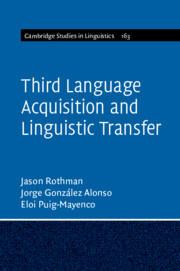Crossref Citations
This Book has been
cited by the following publications. This list is generated based on data provided by Crossref.
Lohndal, Terje
Rothman, Jason
Kupisch, Tanja
and
Westergaard, Marit
2019.
Heritage language acquisition: What it reveals and why it is important for formal linguistic theories.
Language and Linguistics Compass,
Vol. 13,
Issue. 12,
Bayram, Fatih
and
Rothman, Jason
2020.
Formal Linguistics and Language Education.
Vol. 43,
Issue. ,
p.
11.
Xiang, Jingting
and
Yuan, Boping
2020.
Definiteness constraint on subjects in L2 and L3 Mandarin grammars.
Journal of Second Language Studies,
Vol. 3,
Issue. 2,
p.
233.
Guo, Yanyu
and
Yuan, Boping
2020.
Facilitative transfer only?.
Journal of Second Language Studies,
Vol. 3,
Issue. 2,
p.
261.
Abraham, Werner
2020.
Modality in Syntax, Semantics and Pragmatics.
Puig-Mayenco, Eloi
and
Rothman, Jason
2020.
Low proficiency does not mean ab initio: A methodological footnote for linguistic transfer studies.
Language Acquisition,
Vol. 27,
Issue. 2,
p.
217.
Holmes, Bonnie C.
and
Putnam, Michael T.
2020.
Mental representations in receptive multilingual grammars.
Linguistic Approaches to Bilingualism,
Vol. 10,
Issue. 3,
p.
309.
Kubota, Maki
Heycock, Caroline
Sorace, Antonella
and
Rothman, Jason
2020.
Cross-Linguistic Influence on L2 Before and After Extreme Reduction in Input: The Case of Japanese Returnee Children.
Frontiers in Psychology,
Vol. 11,
Issue. ,
Schwartz, Bonnie D.
and
Sprouse, Rex A.
2021.
The Full Transfer/Full Access model and L3 cognitive states.
Linguistic Approaches to Bilingualism,
Vol. 11,
Issue. 1,
p.
1.
Jo, Kyuhee
Kim, Kitaek
and
Kim, Hyunwoo
2021.
Children's interpretation of negation and quantifier scope in L3 English.
Bilingualism: Language and Cognition,
Vol. 24,
Issue. 3,
p.
427.
Fernández Fuertes, Raquel
and
Sánchez Calderón, Silvia
2021.
The syntactic status of English dative alternation structures in bilingual and in monolingual acquisition data.
Linguistic Approaches to Bilingualism,
Vol. 11,
Issue. 6,
p.
817.
Ecke, Peter
and
Hall, Christopher J.
2021.
The Parasitic Model.
Linguistic Approaches to Bilingualism,
Vol. 11,
Issue. 1,
p.
45.
Schwartz, Bonnie D
and
Sprouse, Rex A
2021.
In defense of ‘copying and restructuring’.
Second Language Research,
Vol. 37,
Issue. 3,
p.
489.
2021.
The Cambridge Handbook of Heritage Languages and Linguistics.
p.
579.
Gabriele, Alison
2021.
Microvariation and transfer in L2 and L3 acquisition.
Second Language Research,
Vol. 37,
Issue. 3,
p.
453.
Kupisch, Tanja
Soares, Sergio Miguel Pereira
Puig‐Mayenco, Eloi
and
Rothman, Jason
2021.
A Companion to Chomsky.
p.
232.
Festman, Julia
2021.
Learning and Processing Multiple Languages: The More the Easier?.
Language Learning,
Vol. 71,
Issue. S1,
p.
121.
Ozernyi, Daniil M
2021.
Jason Rothman, Jorge González Alonso, and Eloi Puig-Mayenco: THIRD LANGUAGE ACQUISITION AND LINGUISTIC TRANSFER. Cambridge University Press, 2019.
Applied Linguistics,
Lohndal, Terje
2021.
The Cambridge Handbook of Heritage Languages and Linguistics.
p.
644.
Westergaard, Marit
2021.
Microvariation in multilingual situations: The importance of property-by-property acquisition.
Second Language Research,
Vol. 37,
Issue. 3,
p.
379.





